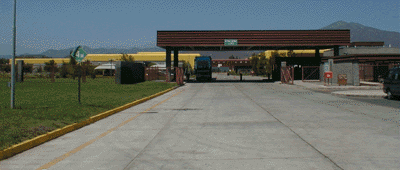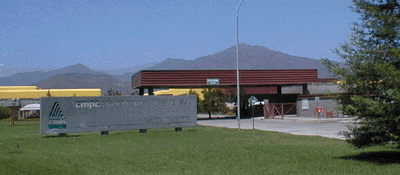|
CMPC is one of Latin America’s largest paper producers and tissue provides a key element for the company's business prospects
By Rita Pappens
Chile's tissue giant rolls on
In North America, the fortunes of the tissue sector are fairly easy to track as the two main producers slug it out to be the biggest and the best. But down in the south of the continent, where the market is far less developed and the field is a little more open, there is a Chilean group that has managed to gain a dominant position across many of the markets in the region.
CMPC is one of South America’s biggest paper producers and tissue just happens to be a core business for the company. Over the years, the Chilean outfit has built up a production base with a uniquely Latin American flavor, operating plants in Chile, Argentina, Peru and Uruguay. CMPC also has a strong belief in growth and with healthy demand being seen across the Latin American tissue market, expansion is the key word for this particular division within the company. As the company points out, tissue has been a good business for CMPC and the group has no intention of letting that potential slip in the future.
Holding firm
In CMPC's ’domestic’ market, the group has earned the title of undisputed market leader in Chile. It has a market share of around 80I, which is especially satisfying in a country where tissue consumption is growing at a rather healthy rate of 4% per year. Chileans have an average per capita consumption of 6 kg/yr and much of that demand is served from CMPC's plants at Talagante and Puente Alto.
Talagante was started up at a greenfield site in 1994 simply because CMPC's existing tissue mill at Puente Alto could not keep up with the pace of demand growth and there was no space to add another machine at the existing site. Talagante is situated about 40 km west of Santiago, in the middle of the country with easy access to urban areas. The mill is unlikely to face the same space constraints as the Puente Alto operation for the foreseeable future as Talagante is located on a 32 ha site. In other words, that leaves plenty of room for expansion, which could come in quite handy as CMPC is already carrying out a feasibility study with a view to adding a second PM in two to three year's time.

The road to tissue expansion stretches out in front of CMPC
The current machine at Talagante is a 2.73 m wide crescent former supplied by Beloit's Brazilian unit. The PM has a capacity of some 33,000 tons/yr and produces tissue in a basis weight range of 15-23 g/m2. Design speed for the machine is 2,000 m/min and the yankee cylinder has a diameter of 4.88 m. ABB supplied the distributed control system (DCS) for the PM.
Output from the tissue machine is converted at the mill. Between 60-70% of the production goes to make roll products such as toilet paper and towels, while the remainder is converted into folded products, mainly handkerchiefs and napkins. Perini of Italy supplied the three roll converting lines, but the seven folded product converting lines came from a range of different suppliers such as Omet, Hobema, Senning, Casmatic and Paper Converting.
In terms of raw materials, 60% of the mill’s furnish is based on virgin fiber sources, with the remaining 40% made up of post-consumer wastepaper bought in the Santiago area from a number of collectors. There are two stock preparation lines at Talagante - one for virgin fiber pulp and one for wastepaper.
The capacity of the virgin fiber line stands at 120 tons/day and essentially the operation starts at the 50 m3 pulper. This is followed by a dump chest and high density cleaners from Lamort. The deflaker was supplied by Beloit, Brazil, along with the refiner.
The 90 ton/day capacity wastepaper line starts with a 25 m3 high density pulper from Lamort, followed by a detrasher, dump chest and high density cleaners. Coarse screening was also supplied by Lamort, as was the slot screening equipment. The mill uses post-consumer waste sorted by low ink content and the company also brings in around 400 tons/month of deinked pulp from CMPC’s Puente Alto mill.
The Puente Alto mill operates two machines - the 2.73 m wide PM 1 is a twin-wire machine that produces mainly deinked fiber tissue. The machine has a capacity of around 100 tons/day, running at 1,500 m/min. PM 2 also trims at 2.73 m and has a capacity of 65 tons/day and a design speed of 850 m/min. This machine is a fourdrinier unit and produces the lower quality "economy" grades. Despite CMPC’s dominance in Chile, the company cannot afford to be complacent. So far, the company produces only branded paper. But it is having to fight hard to resist growing pressure from supermarkets which are keen to push own label brands. Added to that, the company faces competition from imports coming into Chile, mainly high quality grades from Kimberly-Clark in Brazil. At present though, CMPC is holding its own and even exports between 15-20% of its output to neighboring countries, mainly medium and high quality grades.
Foreign ventures
Clearly though, CMPC is not simply confined to Chile in terms of its tissue operations, or indeed, aspirations. The company’s first expansion outside Chile was into neighboring Argentina. The move across to Argentina was a relatively easy decision, according to CMPC. "Argentina has a population of 30 million and although the country had a higher per capita income than Chile, its tissue consumption was lower. In other words, the market had not been well worked," says Carlos Hirigoyen, director of CMPC’s operations in Argentina. "We felt we had something to bring with our technical and commercial know-how."
As a result, Protisa was bought in 1994 for its brand names and converting operations. Jumbo rolls were supplied from Chile and business boomed. So much so in fact that just one year later in 1995, CMPC started up a greenfield mill at Zarate, around 80 km from Buenos Aires. Beloit Brazil supplied the 2.73 m crescent former, which was a sister machine to the one at Talagante in Chile. Following on from there, CMPC bought Papelera del Plata a year later in 1996. The group represented something of a coup, as it was Argentina’s best known tissue producer with a market share of 40%. "The Papelera del Plata purchase was very important," Hirigoyen says. "We immediately got to be the market leader with very strong brand names."
The mill’s location in an urban area in the south of Buenos Aires was a problem though. Expansion was impossible due to environmental problems and CMPC consequently decided to close down its 10,000 ton/yr paper machine and move the converting operations to Zarate. The Buenos Aires plant is now used as a warehouse and distribution center, as well as being the location of the group’s wastepaper collection operation, Corepa.

Talagante has plenty of room for future expansion plans
Creating efficiencies
The Zarate mill had originally been designed as a two PM plant and in April 1999 a second machine started up at the site. The new 65,000 ton/yr PM is a crescent former from Beloit Brazil and the 5.5 m wide machine features a Concept IV headbox as well as a 5.5 m diameter Yankee cylinder. ABB supplied the drives and the process control system. The new 30,000 ton/yr winder is a Vari-Soft from Jagenberg and serves both machines.
The addition of the new PM means that the mill can now operate more efficiently. PM 1 is dedicated to paper napkins and towels, ie whiter, higher quality products, while PM 2 is focused on the high volume products to "deliver a consistent product at lower cost" as Hirigoyen puts it.
Output from the plant consists mainly of tissue made from recycled paper and recent years have seen CMPC invest in a new deinking line with three flotation cells supplied by Beloit Brazil and Lamort. Two flotation cells have also been added to the existing line and the mill now has a capacity of 275 tons/day of deinked pulp. To add even more flexibility, the mill is installing a baling press so deinked pulp can be stored on site.
Other investments at the mill have included a new high storage warehouse for jumbo rolls. CMPC plans to automate the warehouse in the future, but for now the priority is "to keep investments under control and optimize the mill".
Hirigoyen also proudly points out that the Zarate mill was the first in Buenos Aires to get an environmental certificate in May 1998.
The company converts the roll products such as towels and toilet paper at the plant and there are eight converting lines in total - seven supplied by Perini and one by PCMC. Folded products are converted at Naschel - a town some 500 miles west of Buenos Aires. The converting plant came with the acquisition of Papelera del Plata. The eight converting lines at Naschel are mainly supplied by PCMC, USA, and Hobema, Germany. Converting capacity is close to 100,000 tons/yr.
The arrival of CMPC in Argentina has also helped to spur on competitors such as Kimberly-Clark, Celulosa Campana and San Andres de Giles. These companies are investing in new capacity, but CMPC remains Argentina’s favorite supplier with some very strong names such as the Elite Higienol and Sussex brands. CMPC’s market share is now around 50% and the good news is that investments and marketing campaigns have helped to boost tissue consumption from less than 3 kg per capita in 1995 when CMPC first entered the market to more than 4 kg last year.
Further afield in Peru, CMPC started up a greenfield mill in Lima in September 1998 with a second-hand machine that was moved in from Chile. The 2.5 m wide crescent former machine now has a capacity of 30-40 tons/day, producing all types of quality grades, including toilet paper, towels and napkins. The converting equipment is also second-hand.
And finally in Uruguay, CMPC also operates tissue production facilities. The investment in Uruguay dates back to 1994 when CMPC bought the two-machine Ipusa mill. PM 2 produces around 18,000 tons/yr of tissue, while PM 1 produces printing/writing papers.
Clearly, there are still some potential pitfalls for tissue producers in Latin America to face up to. But for CMPC at least, it looks as though the company’s geographical reach and knowledge of the markets are set to pay dividends in a steadily growing sector.
And always assuming that the market remains as healthy as it appears to have been in the recent past, the future looks bright for CMPC.
|